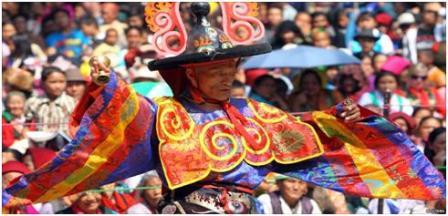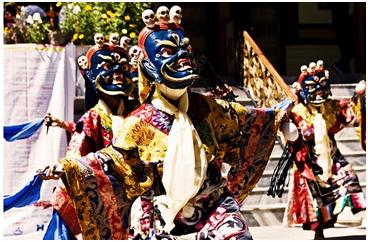Losar the Biggest Festival of Tibetan Buddhist
The grand New Year festival that celebrated by the Tibetan Buddhists Worldwide. "Losar" is celebrated for fifteen consecutive days. Derived from two Tibetan words, the term Losar denotes "New Year". Considered as the most vital celebration in Tibet, Nepal and Bhutan, Losar occurs close or on the same day as the Chinese New Year and the Mongolian New Year. However; celebration of this festival is differ from one place to another as Tibet celebrate its Losar in a very exclusive way, on the first day of Losar, a beverage called changkol/chhaang is made.
 Losar was first celebrated in the Lhokha Yarla Shampo region of Tibet when the apricot trees blossomed, during that time, the festival was known as the Agrarian Festival. As time overtakes, the festival Losar is celebrated by Yolmo, Tamang, Sherpa, Gurung, and Bhutia of different regions in the country and have their own respective new year. In India, the festival is celebrated in the Buddhists County particularly in Himachal Pradesh, Sikkim, Arunachal Pradesh, Ladakh and Zanskar. Losar is usually celebrated in February or March; however the festivities dates can vary between regions to regions.
Losar was first celebrated in the Lhokha Yarla Shampo region of Tibet when the apricot trees blossomed, during that time, the festival was known as the Agrarian Festival. As time overtakes, the festival Losar is celebrated by Yolmo, Tamang, Sherpa, Gurung, and Bhutia of different regions in the country and have their own respective new year. In India, the festival is celebrated in the Buddhists County particularly in Himachal Pradesh, Sikkim, Arunachal Pradesh, Ladakh and Zanskar. Losar is usually celebrated in February or March; however the festivities dates can vary between regions to regions.
Losar in Arunachal Pradesh, 11th February 2015
 Losar festival is one of the important festivals celebrated in the Arunachal Pradesh. The festival is precisely sorted out in the Tawang District by the Monpas (who structures the real divide of populace in Tawang). In Arunachal Pradesh, the celebration is praised with incredible eagerness and bunches of fun. Losar is praised to watch the entry of New Year. It basically falls in month of February or March and Continue for 8 to 15 days.
Losar festival is one of the important festivals celebrated in the Arunachal Pradesh. The festival is precisely sorted out in the Tawang District by the Monpas (who structures the real divide of populace in Tawang). In Arunachal Pradesh, the celebration is praised with incredible eagerness and bunches of fun. Losar is praised to watch the entry of New Year. It basically falls in month of February or March and Continue for 8 to 15 days.
During the festival, homes are unsoiled, religious flags are lifted on each house, sacred scriptures are perused and lamps with butter are lit in all the houses. On the New Year's Day, people wear their finest or new attires. They offer Prasad to the holy place. Prayers are also offered for prosperity and good health of the family members.
Losar in Himachal Pradesh, Mid November to first week of December
 Losar is the New Year celebration of Tibetans, praised principally in the Lahaul area of Himachal Pradesh. It denotes the start of the winter season in the valley and is commended amid the first month of Tibetan calendar, which generally falls in mid-November to first week of December. Amid the Losar celebration, the nearby divinity is adored. Rich imagery and ritual dances are performed in the festivities and celebrations.
Losar is the New Year celebration of Tibetans, praised principally in the Lahaul area of Himachal Pradesh. It denotes the start of the winter season in the valley and is commended amid the first month of Tibetan calendar, which generally falls in mid-November to first week of December. Amid the Losar celebration, the nearby divinity is adored. Rich imagery and ritual dances are performed in the festivities and celebrations.
Losar celebration typically goes on for three days, however it may proceed for ten days in an entirely traditional Tibetan family. During Losar, His Holiness The Dalai Lama', the spiritual head of the Tibetans is worshipped.
 Losar is the Tibetan New Year which is also shared by the Sikkimese. The Sikkimese praises the New Year with full enthusiasm. The youth take to the streets and throw sampa powder onto one another welcoming the New Year. The festival continues for more than a week and there are generally some social occasions in every area. During Losar, fun entertainment includes yak dances, songs, picnics, brocades etc. Visitors are invited in homes amid the Losar festivals to feast with the family.
Losar is the Tibetan New Year which is also shared by the Sikkimese. The Sikkimese praises the New Year with full enthusiasm. The youth take to the streets and throw sampa powder onto one another welcoming the New Year. The festival continues for more than a week and there are generally some social occasions in every area. During Losar, fun entertainment includes yak dances, songs, picnics, brocades etc. Visitors are invited in homes amid the Losar festivals to feast with the family.
 The Ladakhi has its own particular remarkable tradition of commending its New Year celebration Losar. The celebration that praised two months ahead of time on the first day of the eleventh month of the Tibetan Calendar. However; the celebrations start to celebrate on the 29th day of the tenth month. It is a standout amongst the most important social occasions in Ladakh. The festival preparation begins after harvest when people start stocking provision and brewing chhaang. During the month-long festival, Gods, deities, ancestors and animals are fed.
The Ladakhi has its own particular remarkable tradition of commending its New Year celebration Losar. The celebration that praised two months ahead of time on the first day of the eleventh month of the Tibetan Calendar. However; the celebrations start to celebrate on the 29th day of the tenth month. It is a standout amongst the most important social occasions in Ladakh. The festival preparation begins after harvest when people start stocking provision and brewing chhaang. During the month-long festival, Gods, deities, ancestors and animals are fed.
On the day of Losar, the elders of the family are greeted with Khataks and presents blessing. The celebrations end in a procession of people chanting prayers and carrying flaming torches through the lanes of the town to chase away evil spirits that come to stay over the year as a result of the bad deeds.
Losar in Arunachal Pradesh, 11th February 2015
During the festival, homes are unsoiled, religious flags are lifted on each house, sacred scriptures are perused and lamps with butter are lit in all the houses. On the New Year's Day, people wear their finest or new attires. They offer Prasad to the holy place. Prayers are also offered for prosperity and good health of the family members.
Losar in Himachal Pradesh, Mid November to first week of December
Losar celebration typically goes on for three days, however it may proceed for ten days in an entirely traditional Tibetan family. During Losar, His Holiness The Dalai Lama', the spiritual head of the Tibetans is worshipped.
On the day of Losar, the elders of the family are greeted with Khataks and presents blessing. The celebrations end in a procession of people chanting prayers and carrying flaming torches through the lanes of the town to chase away evil spirits that come to stay over the year as a result of the bad deeds.